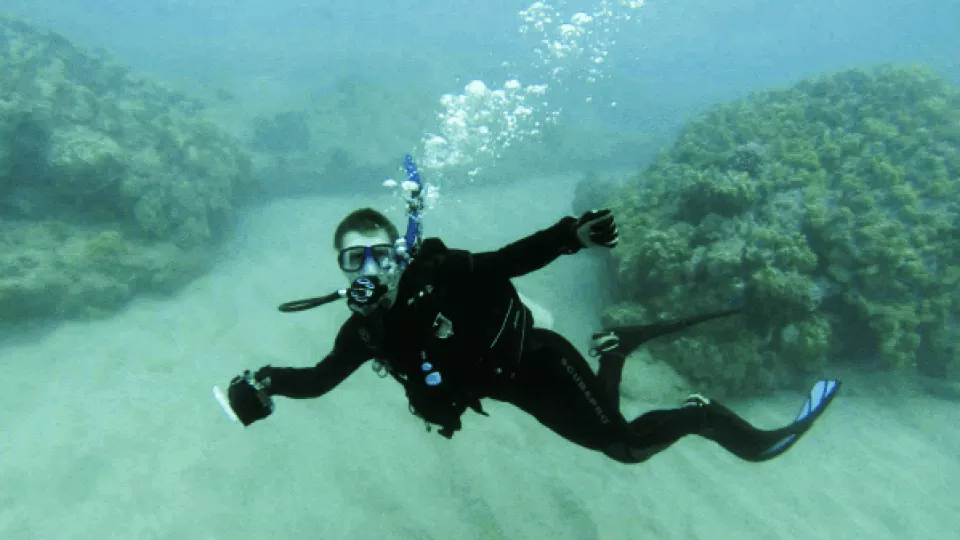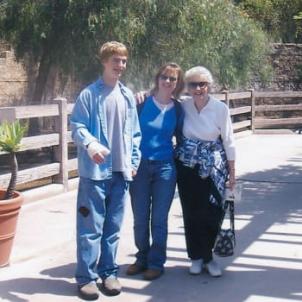
In Motion
Dieter Stelling feels right at home in the ocean, where he loves to dive and snorkel, exploring marine life. Out of the water, he prefers to be hiking or rock climbing — always on the move.
Unfortunately, in late 2015, the 26-year-old found it difficult to even walk short distances without pain. The reason: a rare genetic condition called hereditary multiple exostoses, or HME, in which bony spurs — cartilage-capped benign bone tumors — develop around area of active bone growth, particularly the long bones of the body.
Hereditary Multiple Exostoses Patient Gives Back
Shortly after birth, Dieter was diagnosed with HME, which has been linked with mutations in three genes. His mother, who also has the inheritable condition, felt a small bone spur on one of her newborn’s legs, and she knew what it was, even before doctors confirmed it.
The family resided in Sacramento at the time and young Dieter had several procedures there to remove bone growths. Then, when he was 7, his parents both found jobs in Southern California.
A top orthopedic center
There the family discovered Children’s Hospital Los Angeles and its esteemed Children’s Orthopedic Center, now ranked in the top 10 pediatric orthopedic programs nationwide by U.S. News and World Report. It soon became one of the reasons the Stellings decided to settle in L.A.

The Children’s Orthopedic Center was then headed by Vernon Tolo, MD, now chief emeritus, who became Dieter's orthopedic surgeon. “Even at that age, I was impressed by how dedicated Dr. Tolo and everyone there was,” says Dieter.
Over the years, he has had multiple surgeries—so many he’s stopped keeping track, he says—“easily more than a dozen.” Each time, CHLA doctors removed more of the bony spurs that, depending on their location, can cause pain or numbness from nerve compression, along with vascular problems, irritated tendons and muscles, and restricted range of motion. HME also leaves people at an increased risk of developing a rare form of bone cancer.
With the medical intervention from the Children’s Orthopedic Center, Dieter was able to attend college in one of his dream locations—Hawaii. He graduated from the University of Hawaii at Manoa in 2013 with a double major in zoology and marine biology, and began working for the National Oceanic and Atmospheric Association (NOAA) monitoring local fisheries.
Away from the job, he pursued his passion for underwater photography, capturing and selling photos of sea turtles, dolphins and stingrays. Then life intervened.
Movement, interrupted
By 2015, his bone tumors—they number in the hundreds, says Dieter—were causing new problems. Growths on his hip joints, in particular, were impeding his muscles and tendons. Not only were diving and hiking out of the question, so was walking even short distances. A seemingly simple action like bending down to tie his shoes became impossible. “I had trouble lifting my legs and needed to use a cane,” Dieter recalls. Often the pain was so excruciating, he went weeks without any significant sleep.

After seven years in Hawaii, Dieter moved back home to Los Angeles. He returned to the Children’s Orthopedic Center, which two years ago launched the Hip Preservation Program, the only program of its kind in Southern California.
One of the program’s priorities is “to try to prevent children and young adults from needing whole-hip replacements in their 20s or 30s,” says Rachel Goldstein, MD, MPH, a CHLA orthopedic surgeon and hip specialist.
The Hip Preservation Program specializes in diagnosing and treating congenital and developmental hip disorders, post-traumatic hip abnormalities, sports-related hip injuries, and adolescent and young-adult hip pain. Its orthopedic surgeons are specially trained in hip reconstruction and total-hip replacement. These experts routinely perform complex, leading-edge surgical procedures for a wide range of both rare and common conditions, including deformities of the hip joint and femur (the long bone of the leg), as well as hip dysplasia (dislocation of the hip joint).
More on CHLA's Hip Preservation Program
The orthopedic team calls on the latest diagnostic techniques such as 3-D imaging, ultrasound, bone scans, arthrography (fiber-optic video cameras), computed tomography, magnetic resonance imaging, EOS imaging, and gait or motion analysis, which let them see the hip joint up close to plan their surgical approach.
Specialized pediatric expertise
Avoiding a full hip replacement and minimizing the surgical intervention in a child, teen or young adult takes specialized skills, notes Goldstein. A typical hip replacement lasts about 15 to 20 years. “It’s one thing to do that procedure on someone who is 60 years old, who may only need one revision,” she says. “It’s another thing to have it at 16, and face a lifetime of revisions.”
One of the Hip Preservation Program’s greatest strengths is its comprehensiveness.
“We work together to make sure each patient is getting the best intervention by the best person for their condition,” she adds.
In Dieter’s case, that person was Goldstein, whom he calls “really smart and funny.” He had complete confidence in her and the Children’s Orthopedic Center. “It’s so hard to find a doctor who even knows what HME is,” Dieter says, “much less one who treats adults. With Children’s Hospital, I don’t have to search around for one—these people have my back.”
On Nov. 22, 2015, Goldstein operated on Dieter’s left hip. In the four-hour operation, she took apart the hip joint—essentially a ball-and-socket construction—and cleaned out around the socket, removing the major bony spurs impeding his movement. Then she reconstructed the joint, inserting three 6-inch-long titanium surgical screws, which would come out months later after the hip had a chance to heal.
Dieter went home after only two days in the hospital. He soon felt greater motion in that hip and, while still on crutches, was ready to have the second operation. Goldstein advised a waiting period of four months to allow his left hip to recover. After she removed the screws (which Dieter still keeps on his kitchen table), it was time for a similar surgery on his right hip in March 2016.
He started his second recovery period and was able to go back to swimming as part of his rehabilitation. He’s regained more rotation in both hips and is working on achieving more flexibility. Most important, he can now walk without pain. “Things are looking better already,” says Dieter.
Life-changing research
In addition to advancing state-of-the-art surgical techniques, the Hip Preservation Program is engaged in innovative research, including investigations into developmental hip dysplasia, a condition that is present at birth.
Team members are also involved in a multicenter study with Vanderbilt University focused on finding genetic biomarkers for slipped capital femoral epiphysis (SCFE), the most common hip disorder in adolescents. It typically affects growing children ages 10 to 15 and occurs when the ball of the hip begins to slip at the growth plate. The program also participates in the International Perthes Study Group, which is seeking answers for Legg-Calve-Perthes disease, a childhood disorder resulting from loss of blood supply to the femoral head of the hip joint.
CHLA Helps Orthopedic Patient Walk, Run, Dance
For Dieter, the Children’s Orthopedic Center has given him back a chance to simply move again. He’s not sure what the future holds once he recovers from the double surgery, but he hopes it involves some hiking and even climbing a rock or two. After a lifetime of medical procedures, he’d rather spend his time outdoors, not inside a hospital. But if he has to be in one, CHLA is, in his opinion, “awesome.”
“They aren’t just smart,” he says of the doctors and staff at the Children's Orthopedic Center, “they’re good with people. They make you feel like you’re going to a family, not a hospital. When you walk in, the staff waves at you and says hi. You don’t get that many places. And they do all they can to make sure I still get the treatments I need from the specialists they have.”
How you can help
To help kids just like Dieter, consider making a donation to Children's Hospital Los Angeles. Visit CHLA.org/Donate.


